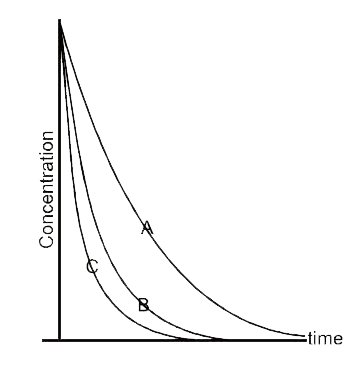The decay profiles of three radioactive species A, B and C are given below :

These profiles imply that the decay constants kA, kB and kC follow the order
KA>KB>KC
KA>KC>KB
KB>KA>KC
KC>KB>KA
The correct Answer is:D
KC>KB>KA
Topper's Solved these Questions
- QUESTION PAPER 2013BOOK - KVPY PREVIOUS YEARCHAPTER - QUESTION PAPER 2013EXERCISE - PART-II (CHEMISTRY)
5 Videos
- QUESTION PAPER 2013BOOK - KVPY PREVIOUS YEARCHAPTER - QUESTION PAPER 2013EXERCISE - PART-I ( CHEMISTRY)
20 Videos
- MOCK TEST 9BOOK - KVPY PREVIOUS YEARCHAPTER - MOCK TEST 9EXERCISE - EXERCISE
26 Videos
- QUESTION PAPER 2020BOOK - KVPY PREVIOUS YEARCHAPTER - QUESTION PAPER 2020EXERCISE - PART-II(CHEMISTRY)
10 Videos
Similar Questions
A radioactive substance A having N0 active nuclei at t=0, decays to another radioactive substance B with decay constant λ1. B further decays to a stable substance C with decay constant λ2. (a) Find the number of nuclei of A,B and C time t. (b) What should be the answer of part (a) if λ1>>λ2 and λ1<<λ2
View Solution
A ball moves over a fixed track as shown in thre figure. From A to B the ball rolls without slipping. If surface BC is frictionless and KA,KB and KC are kinetic energies of the ball at A, B and C respectively then
(a). hA>hC,KB>KC
(b). hA>hC,KC>KA
(c). hA=hC,KB=KC
(d). hA<hC,KB>KC
View Solution
Knowledge Check
The energy profile of the reaction: is shown as A+B⇔C is shown as,

The equilibrium constant for the said equilibriumAincreases with the increase in temperatureBdecreases with the increase in temperatureCdoes not change with the change in temperatureDis equal to the rate constant of the forward reactionIf mg of a radioactive species (molar mass M) has decay constant λ The specis activity of sample at t= is given by:
Aλ.NAMBλ.NA.mMCλ.mMDm−MeλThe rate of reaction A+B+C→ Products is given Rate =K[A]12[B]13[C]. The order of the reaction is
A1B3C56D116
Three rods of the same dimension have thermal conductivities 3K, 2K and K. They are arranged as shown in fig. Given below, with their ends at 100∘C,50∘C and 20∘C. The temperature of their junction is :-

View SolutionRadioactive decay follows first order kinetics and the rate constant is often termed as decay constant. Certain radioactive substance may undergo sequential decays in order to convert into a stable necleus The series comprising all such elements is termed as radioactive disintegration series.
A radioactive series is formes such that after each α decay there are two consecutive β decay and the cycle repeats How many different elements this series can have if there are 12 members in the series?
View SolutionRadioactive decay follows first order kinetics and the rate constant is often termed as decay constant. Certain radioactive substances may undero sequential decays in order to convert into a stable nucleus. The series comprising all such elements is termed as radioactive disintegration series.
A radioactive series is formed such that after each α decay there are two consecutive β decay and the cycle repeats. How many different elements this series can have if there are 12 members in the series ?
View SolutionRadioactive decay follows first order kinetics and the rate constant is often termed as decay constant. Certain radioactive substance may undergo sequential decays in order to convert into a stable necleus The series comprising all such elements is termed as radioactive disintegration series.
If a radioactive disintegration series is observed involving only αandβ decays then which of the following isotopes cannot be a part of it if the parent isotope of the series is .91Pa234?
View SolutionRadioactive decay follows first order kinetics and the rate constant is often termed as decay constant. Certain radioactive substances may undero sequential decays in order to convert into a stable nucleus. The series comprising all such elements is termed as radioactive disintegration series.
If a radioactive disintegration series is observed involving only α and β decays then which of the following isotopes cannot be a part of it if the parent isotope of the series is .91Pa234.
View Solution
